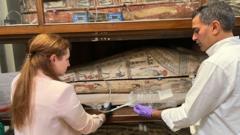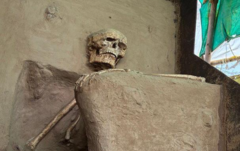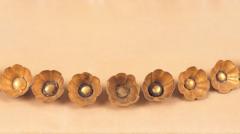A recent study reveals that ancient Egyptian mummies produce "woody," "spicy," and "sweet" aromas, providing insights into historical embalming practices and conservation methods.
Ancient Egyptian Mummies Reveal Surprising Fragrance After Millennia

Ancient Egyptian Mummies Reveal Surprising Fragrance After Millennia
Scientists find that ancient mummies, despite thousands of years in a sarcophagus, emit surprisingly pleasant scents.
A groundbreaking study has uncovered that ancient Egyptian mummies, even after 5,000 years, continue to emit surprisingly pleasant aromas. Researchers examined nine mummies and found that, while the intensity varied, all exhibited scents described as “woody,” “spicy,” and “sweet.” The study's findings aim to offer a sensory pathway into history, as scientists plan to chemically recreate the scents for display in the Egyptian Museum in Cairo.
Cecilia Bembibre, a leading researcher, expressed the team's excitement about sharing the experience of those mummified bodies through scent reconstruction. During the mummification process, ancient Egyptians were known to enhance the corpses with pleasing smells, which played a critical role in preparing a spirit for the afterlife. Consequently, pharaohs and nobility were lavishly adorned with fragrant oils, waxes, and balms.
In an unexpected twist, Bembibre noted that contrary to the horror films and literature that depict mummies unfavorably, their scents were refreshingly pleasant. The research team, which included members from UCL and the University of Ljubljana, employed a non-invasive technique, inserting a tiny tube into the sarcophagus to extract scents without contaminating the mummies.
Art historian Ally Louks, who specializes in the intersection of smell and literature, praised the study as a revolutionary method of engaging with history. She remarked on how smell evokes strong emotional connections, stating, "We know smells were essential to social, religious and personal practices [in ancient Egypt]."
Additionally, Matija Strlič, another researcher, highlighted that these scents could provide insights into the social status of the deceased. He stated, “We believe that this approach is potentially of huge interest to other types of museum collections.”
Beyond enhancing visitor experience, the research findings also present significant implications for mummy conservation. Using gas chromatography, the team identified various components of the embalming scents, which are crucial for understanding the mummification process. These insights may help conservators determine appropriate methods for storing and wrapping mummies to ensure their preservation for future generations. Dr. Bembibre concluded that this research is essential for protecting and passing on ancient artifacts to subsequent cultures.



















